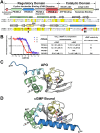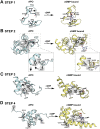Crystal structures of the carboxyl cGMP binding domain of the Plasmodium falciparum cGMP-dependent protein kinase reveal a novel capping triad crucial for merozoite egress
- PMID: 25646845
- PMCID: PMC4412288
- DOI: 10.1371/journal.ppat.1004639
Crystal structures of the carboxyl cGMP binding domain of the Plasmodium falciparum cGMP-dependent protein kinase reveal a novel capping triad crucial for merozoite egress
Abstract
The Plasmodium falciparum cGMP-dependent protein kinase (PfPKG) is a key regulator across the malaria parasite life cycle. Little is known about PfPKG's activation mechanism. Here we report that the carboxyl cyclic nucleotide binding domain functions as a "gatekeeper" for activation by providing the highest cGMP affinity and selectivity. To understand the mechanism, we have solved its crystal structures with and without cGMP at 2.0 and 1.9 Å, respectively. These structures revealed a PfPKG-specific capping triad that forms upon cGMP binding, and disrupting the triad reduces kinase activity by 90%. Furthermore, mutating these residues in the parasite prevents blood stage merozoite egress, confirming the essential nature of the triad in the parasite. We propose a mechanism of activation where cGMP binding allosterically triggers the conformational change at the αC-helix, which bridges the regulatory and catalytic domains, causing the capping triad to form and stabilize the active conformation.
Conflict of interest statement
The authors have declared that no competing interests exist. The authors also have no affiliation or competing interest with the Eli Lilly company. Eli Lilly has no role in designing and conducting this study. This does not alter our adherence to all PLOS Pathogens policies on sharing data and materials.
Figures





Similar articles
-
Malaria parasite cGMP-dependent protein kinase regulates blood stage merozoite secretory organelle discharge and egress.PLoS Pathog. 2013 May;9(5):e1003344. doi: 10.1371/journal.ppat.1003344. Epub 2013 May 9. PLoS Pathog. 2013. PMID: 23675297 Free PMC article.
-
Plasmodium falciparum Guanylyl Cyclase-Alpha and the Activity of Its Appended P4-ATPase Domain Are Essential for cGMP Synthesis and Blood-Stage Egress.mBio. 2021 Jan 26;12(1):e02694-20. doi: 10.1128/mBio.02694-20. mBio. 2021. PMID: 33500341 Free PMC article.
-
cGMP Binding Domain D Mediates a Unique Activation Mechanism in Plasmodium falciparum PKG.ACS Infect Dis. 2018 Mar 9;4(3):415-423. doi: 10.1021/acsinfecdis.7b00222. Epub 2017 Dec 26. ACS Infect Dis. 2018. PMID: 29251493
-
Cyclic nucleotide selectivity of protein kinase G isozymes.Protein Sci. 2021 Feb;30(2):316-327. doi: 10.1002/pro.4008. Epub 2020 Dec 10. Protein Sci. 2021. PMID: 33271627 Free PMC article. Review.
-
The role of cGMP signalling in regulating life cycle progression of Plasmodium.Microbes Infect. 2012 Aug;14(10):831-7. doi: 10.1016/j.micinf.2012.04.011. Epub 2012 May 3. Microbes Infect. 2012. PMID: 22613210 Free PMC article. Review.
Cited by
-
Keep a lid on it: A troika in kinase allostery.J Biol Chem. 2020 Jun 19;295(25):8492-8493. doi: 10.1074/jbc.H120.014383. J Biol Chem. 2020. PMID: 32561554 Free PMC article.
-
Plasmodium falciparum Cyclic GMP-Dependent Protein Kinase Interacts with a Subunit of the Parasite Proteasome.Infect Immun. 2018 Dec 19;87(1):e00523-18. doi: 10.1128/IAI.00523-18. Print 2019 Jan. Infect Immun. 2018. PMID: 30323024 Free PMC article.
-
Aberrant phase separation of two PKA RIβ neurological disorder mutants leads to mechanistically distinct signaling deficits.Cell Rep. 2025 Jun 24;44(6):115797. doi: 10.1016/j.celrep.2025.115797. Epub 2025 Jun 11. Cell Rep. 2025. PMID: 40512625 Free PMC article.
-
Crystal Structure of PKG I:cGMP Complex Reveals a cGMP-Mediated Dimeric Interface that Facilitates cGMP-Induced Activation.Structure. 2016 May 3;24(5):710-720. doi: 10.1016/j.str.2016.03.009. Epub 2016 Apr 7. Structure. 2016. PMID: 27066748 Free PMC article.
-
cGMP: a unique 2nd messenger molecule - recent developments in cGMP research and development.Naunyn Schmiedebergs Arch Pharmacol. 2020 Feb;393(2):287-302. doi: 10.1007/s00210-019-01779-z. Epub 2019 Dec 18. Naunyn Schmiedebergs Arch Pharmacol. 2020. PMID: 31853617 Free PMC article. Review.
References
-
- Cowman AF, Crabb BS (2006) Invasion of red blood cells by malaria parasites. Cell 124: 755–766. - PubMed
Publication types
MeSH terms
Substances
Associated data
- Actions
- Actions
Grants and funding
LinkOut - more resources
Full Text Sources
Other Literature Sources

